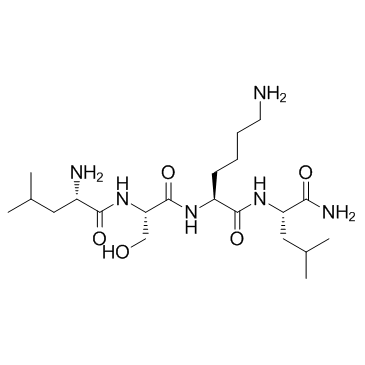
LSKL(a)
CAS No. 283609-79-0
LSKL(a)( —— )
Catalog No. M20897 CAS No. 283609-79-0
LSKL Inhibitor of Thrombospondin (TSP-1) is a peptide derived from the latency-associated peptide inhibits thrombospondin (TSP-1) activation of TGF-β.
Purity : >98% (HPLC)
 COA
COA
 Datasheet
Datasheet
 HNMR
HNMR
 HPLC
HPLC
 MSDS
MSDS
 Handing Instructions
Handing Instructions
| Size | Price / USD | Stock | Quantity |
| 2MG | 50 | In Stock |


|
| 5MG | 73 | In Stock |


|
| 10MG | 118 | In Stock |


|
| 25MG | 220 | In Stock |


|
| 50MG | 330 | In Stock |


|
| 100MG | 495 | In Stock |


|
| 200MG | Get Quote | In Stock |


|
| 500MG | Get Quote | In Stock |


|
| 1G | Get Quote | In Stock |


|
Biological Information
-
Product NameLSKL(a)
-
NoteResearch use only, not for human use.
-
Brief DescriptionLSKL Inhibitor of Thrombospondin (TSP-1) is a peptide derived from the latency-associated peptide inhibits thrombospondin (TSP-1) activation of TGF-β.
-
DescriptionLSKL Inhibitor of Thrombospondin (TSP-1) is a peptide derived from the latency-associated peptide inhibits thrombospondin (TSP-1) activation of TGF-β.
-
In VitroThe KTFR sequence from ADAMTS1 is responsible for the interaction with the LSKL, Inhibitor of Thrombospondin (TSP-1) (LSKL peptide) from the latent form of TGF-β, leading to its activation. There is a stable binding mode between LSKL, Inhibitor of Thrombospondin (TSP-1) and ADAMTS1 KTFR sequence, characterized by 3 salt bridges and 2 hydrogen bonds.
-
In VivoLSKL, Inhibitor of Thrombospondin (TSP-1) (1 mg/kg; intraperitoneal injection; male Sprague-Dawley rats) is protective against subarachnoid fibrosis, attenuates ventriculomegaly and effectively suppresses hydrocephalus. LSKL, Inhibitor of Thrombospondin (TSP-1) treatment inhibits TGF-β1 activity and subsequent Smad2/3 signaling.LSKL, Inhibitor of Thrombospondin (TSP-1) (30 mg/kg, i.p.) successfully inhibits transforming growth factor (TGF) β-Smad signal activation induced by partial hepatectomy. LSKL, Inhibitor of Thrombospondin (TSP-1) successfully attenuates TGF-β-Smad signal activation by antagonizing TSP-1, but not by reducing TSP-1 protein expression. LSKL, Inhibitor of Thrombospondin (TSP-1) accelerates hepatocyte proliferation after hepatectomy. Animal Model:103 male Sprague-Dawley rats (6 weeks of age; 160-180 g) with subarachnoid hemorrhage (SAH) Dosage:1 mg/kg Administration:Intraperitoneal injection Result:Was protective against subarachnoid fibrosis, attenuated ventriculomegaly and effectively suppressed hydrocephalus.
-
Synonyms——
-
PathwayOthers
-
TargetOther Targets
-
RecptorTGFβ
-
Research Area——
-
Indication——
Chemical Information
-
CAS Number283609-79-0
-
Formula Weight458.6
-
Molecular FormulaC21H42N6O5
-
Purity>98% (HPLC)
-
SolubilityDMSO:100 mg/mL (218.05 mM)
-
SMILESCC(C)CC(N)C(=O)NC(CO)C(=O)NC(CCCCN)C(=O)NC(CC(C)C)C(N)=O
-
Chemical Name——
Shipping & Storage Information
-
Storage(-20℃)
-
ShippingWith Ice Pack
-
Stability≥ 2 years
Reference
1.Liao F Li G Yuan W.et al.LSKL peptide alleviates subarachnoid fibrosis and hydrocephalus by inhibiting TSP1-mediated TGF-β1 signaling activity following subarachnoid hemorrhage in rats.Exp Ther Med. 2016 Oct;12(4):2537-2543.
molnova catalog



related products
-
Dipotassium glycyrrh...
Dipotassium glycyrrhizinate is an anionic surfactant having anti-allergic and anti-inflammatory activities.
-
(3S)-3,7-dimethyloct...
(3S)-3,7-dimethyloctan-1-ol ((S)-3,7-dimethyl-1-octanol) can be used to synthesize liquid crystal compounds and nanoparticles.
-
BIO-11006 acetate sa...
BIO-11006 acetate salt is a polyglycosylated alanine rich C kinase substrate (MARCKS) inhibitor similar to MANS peptides.



 Cart
Cart
 sales@molnova.com
sales@molnova.com


